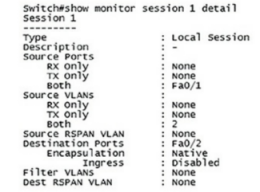- Home
- Networking
- CCNA Routing and Switching 200-125
136.
Which statement is correct about the following exhibit?

- A.The source interface is Fa0/1 with a destination interface of Fa0/2.
- B.The source interface is Fa0/2 with a destination interface of Fa0/1.
- C.The source interface is Fa0/1 with a destination interface of Fa0/2 via VLAN 2.
- D.The source interface is Fa0/1 and VLAN 2 with a destination interface of Fa0/2.
- Answer & Explanation
- Report
Answer : [D]
Explanation :
Explanation :
| The details of the output show that monitor session 1 is configured to capture interface Fa0/1 and VLAN 2 in both directions. The destination interface is Fa 0/2. |
137.
Which command will configure the destination port for a SPAN session? Assume
that you are working with session 1 and the destination port is Gi 1/14.
- A.Switch(config)#monitor session 1 destination gi 1/14
- B.Switch(config)#monitor span 1 destination gi 1/14
- C.Switch(config)#monitor session 1 destination interface gi 1/14 both
- D.Switch(config)#monitor session 1 destination interface gi 1/14
- Answer & Explanation
- Report
Answer : [D]
Explanation :
Explanation :
| The command monitor session 1 destination interface gi 1/14 will configure the interface of Gi1/14 as the destination interface for the SPAN session.The direction can be omitted because it is specified on the source interface. The destination interface will receive a copy of the frames that are configured on the source interface. |
138.
Which command will configure the removal of a SPAN session 1?
- A.Switch(config)#no span session 1
- B.Switch(config)#no session span 1
- C.Switch(config)#no monitor session 1
- D.Switch(config)#clear monitor session 1
- Answer & Explanation
- Report
Answer : [C]
Explanation :
Explanation :
| The command no monitor session 1 will remove the currently configured monitor session of 1 from the configuration. |
139.
You need to create a SPAN session for five Fast Ethernet ports. You want to watch
both the tx (transmit) and rx (receive) on the ports. What is the sizing of the
destination port you will require?
- A.100 Mb/s
- B.1 Gb/s
- C.10 Gb/s
- D.40 Gb/s
- Answer & Explanation
- Report
Answer : [B]
Explanation :
Explanation :
| The sizing of the destination port should be equal to the amount of bandwidth that the source ports collectively can generate. When performing this calculation, you must take into account both the RX and TX. For example, five Fast Ethernet ports can transmit at 5 × 100 Mb/s = 500 Mb/s. They can also receive at 500 Mb/s since you are capturing both directions. The proper sizing of the destination port should be 1 Gb/s so that traffic is not lost out of the exit interface for the packet capture device. |
140.
Which command will configure a SPAN session for an entire VLAN as a source,
assuming it’s VLAN 23?
- A.Switch(config)#monitor session 1 source vlan 23
- B.Switch(config)#session span 1 source vlan 23
- C.Switch(config)#monitor session 1 source interface vlan 23 both
- D.Switch(config)#monitor session 1 vlan 23 both
- Answer & Explanation
- Report
Answer : [A]
Explanation :
Explanation :
| The command monitor session 1 source vlan 23 will configure the SPAN session of 1 with a source of VLAN 23. When you’re configuring a VLAN as the source of a SPAN session, the direction is irrelevant since the parameter of both is implied. |